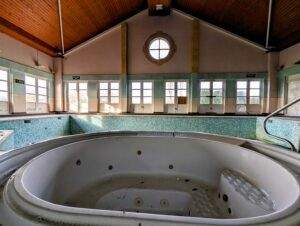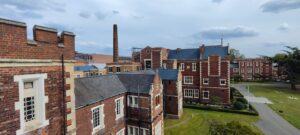Abandoned Hampshire: Pump House | Urbex

This place was intriguing to me to explore. To look at, it was always so tantalisingly close, yet so far.
This pump house sits on a waterway that was popular with shipping and is now part of an site belonging to the national grid. It also sits close to publicly accesssible areas, so it is fiercely locked-down with strong fences, CCTV cameras, motion sensors, private security and guard dogs. It’s merely by chance that I was in the right place, at the right time and allowed guided access. This pump house was constructed just before WW2, around the time art-deco was all the rage- today’s explore revealed how a lot of this style was still on display.




The vast intirior of the building came into view as I entered through the service hatch. The National Grid substation loomed before me and hid away the historic part of the pump house I was intrigued by.
My guide turned off the alarms and escorted me in as I happily clicked away with the camera. The first thing that hit me was everything seemed like it was out of old-timey Hollywood. Despite a few modern signs and pieces of machinery, it felt like a step back in time. The dials, switches and displays had the feel of an old horror flick, where a mad scientist is bringing his creation to life while needles go haywire on displays around him.




As I carefully walked around, I noticed just how much machinery there was, most of it still in place. I had no idea what a lot of the technology did, but interestingly everything was still labelled. Wires still looked to be connected and the facility seemed as if it could be brought back to life in a heartbeat, despite everything being covered in dust. The most impressive part of the pump house was the four water pumps that lined up in the middle of the room, looking like oversized salt and pepper shakers. My guide informed me that back in the day when they operated these, they were able to move over a million litres of water a minute from the waterway.





Extending along the pump house was a raised wooden platform. My guide escorted me up to the platform which housed all the control switches to control these mighty pumps. I stood in awe at the control panel, to me, it looked like something out of a Gerry Anderson production (think Thunderbirds), maybe with a slight art-deco twist. A huge console with analogue dials, displays, switches and knobs lay before me with a huge map, covered with bulbs, showing where and how the water was pumped.
The control panels also hinted at a history that never came to pass, as some dials referred to a waterway that didn’t exist, so I asked my guide what these were. He informed me that these controls were added for an additional waterway that was meant to be constructed shortly after the pump house was built. However, the outbreak of WWII meant that the funding was funnelled into the war effort instead and these plans never came to fruition, however, the controls remained, never to be used.



A small office room at the end of mezzanine looked like it could be put back into use tomorrow as it lay empty aside from some cupboards and a sink. Overall it was in good nick aside from being a tad dusty. The windows for this office were plastered with a wide variety of stickers, some newer, some older; it was clear that someone who worked in this office added these stickers to add their own personal touch to their place of work, adding to the personal history of this incredible building.
There was one part of this place I direly wanted to see but wasn’t allowed- underneath the pumping station. Vast open gaps in the floor showed me walkways that led down into the Earth, though I was told these tunnels have started to flood with water from the waterway, evidenced by the sound of water dripping down into the vast tunnels below. Checking National Grid’s website shows they have little to no interest of preserving the tunnels, only the pumping building itself. So it’s probably the case that in time, these tunnels will become completely inaccessible due to water leaking in.







Nonetheless, being able to go into this building and see what is normally kept out of the public eye was a beautiful thing, I am lucky to have been escorted around and to have shown up on that day. I’m also lucky I was able to share these images with you. I’m hoping that one day soon, I may be able to go back and have another look around with permission.
Last Updated on 20 January 2025 by Michael





This place looks amazing I’m working in a small movie at the moment and we would love to film there if possible is there any way we could get the location?